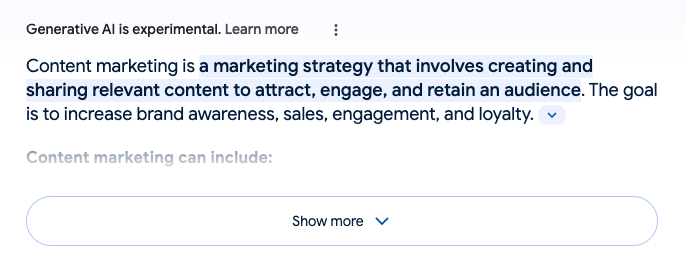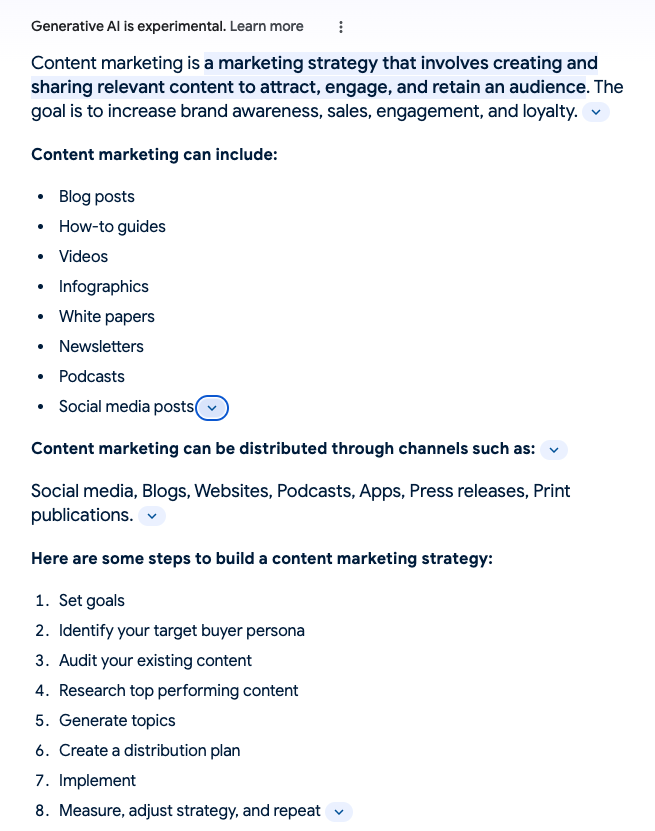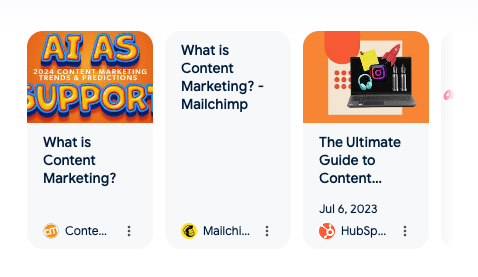Shock waves from three major search trends are shaking the industry to its core vitals.
There’s no need to panic. Brands still have viable options for driving engagement and traffic through search. But it’s a good time to revisit your SEO strategy so your valuable content doesn’t get buried where your audience won’t find it.
We asked search industry leaders to explain the new complications and threats to your brand’s content. Here are the SEO trends they’re tracking and the actions they recommended to fortify your content for information-hungry audiences:
Uh-oh 1: Google’s SGE is shifting the dynamics of search in Google’s favor
In May 2023, Google launched an experimental project, Search Generative Experience (SGE). It uses AI technology to provide searchers with detailed informational snapshots at the top of most search engine results pages (SERPs).
Here is a snapshot for the query, “What is content marketing?” The first image shows an SGE format Google is testing. The “collapsed state” unit displays a truncated answer users can click on to explore it more deeply.
Clicking the show-more button or arrow expands the unit to display a more detailed response, including lists of content types, distribution channels, and steps for building a content marketing strategy.
What are the problems?
Marketers have several reasons to be concerned, not the least of which is that SGE takes over the most coveted search engine real estate. That means organically well-ranked content and paid search placements get pushed down — and possibly off — the first page.
Search visibility and referral traffic will likely suffer
But the bigger issue is that SGE snapshots are designed to deliver a satisfying zero-click experience, where consumers don’t need to leave the SERP to get all the information and answers they sought.
Currently, SGE is only available to users who sign up for free access to its Google Labs environment. But Mike King, founder of iPullRank, says once it’s launched as the default experience for everybody, publishers’ search-driven traffic will take a big hit.
“You’re going to lose a lot of visibility on SERPS, and you’re going to lose a lot of referral traffic,” Mike says. “Why would searchers click on your content links if the specific answers they came for are placed right in front of them?”
Yet BrightEdge founder and executive chair Jim Yu believes what you might lose in referral traffic volume could balance out with richer, more robust information available on search. More top-of-the-funnel interactions will happen inside the SGE. Consumers who do click are ready to convert. “The traffic you receive would be higher quality and more monetizable,” Jim says.
SGE captures your content’s value but keeps the benefits
How SGE sources the information displayed in its snapshots raises another concern for brands. Like any AI-powered search tool (including search bots), it crawls websites and other online content, scraping the most relevant chunks of information and adding it to its large language model (LLM).
Mike explains that to compile a snapshot, SGE analyzes the keywords and intent of the user’s query. Then, it uses a process called retrieval-augmented generation (RAG) to aggregate relevant source materials in its LLM and serve an answer that its calculations determine to be the most contextually relevant.
If Google’s search engine ranks your content as the most authoritative, accurate, and satisfying response, it may appear as the SGE answer. But with only one of these spots available, earning that honor is a long shot.
Alternatively, in SGE mode, Google’s AI might aggregate content from several sources to generate a snapshot. While it credits each source for its contribution, its approach doesn’t motivate searchers to explore those source articles. (In the image below, you can see that this module credits sources at the bottom of the answer with the article title, a thumbnail image, and a snippet of the meta description.)
What should you do?
The full impact of SGE is unlikely to come into focus until it moves out of beta testing and into the open market. That gives you ramp-up time to adapt your SEO approach to get your content featured in SGE — but only if that’s a goal worth pursuing for your business.
Optimize for intent and contextual relevance
SGE is designed to provide a more immersive, satisfying experience on the search page. To demonstrate that your content offers that experience, you need to understand your audience’s search intentions and the signals SGE’s engine uses to gauge relevance against their queries.
Many SEO best practices and research processes still apply, but some have become more critical. Persona-driven keyword research is among them. “Mapping keywords to your user journey stages will give you a clearer understanding of who’s searching, what they’re trying to accomplish, and what’s motivating them to search,” Mike says. “Ultimately, that should inform your strategy.”
Here’s one reason you need that clearer understanding: SGE doesn’t just take a user’s query at face value. It gathers contextual information from their previous queries. This enables it to get highly specific in pinpointing the user’s intent — and deliver the best content to satisfy it.
For clues about what information Google factors into those calculations, look at another SGE format in the beta test — the carousel of resources.
In this example, based on the query “What is content marketing,” you can see the titles and cover images for articles from CMI, Mailchimp, and HubSpot. It suggests the importance of optimizing headline and image copy to include the question-related terms that might appear in the user’s initial query or follow-up questions.
Jim also recommends optimizing image alt-text, meta descriptions, and other metadata. Doing so may help SGE determine if users are likely to explore your content in more detail or just keep scrolling through the carousel. “As we learned several times in the past, the future of SEO is not about fighting against the tide but learning how to ride the waves,” Jim says.
Search SGE’s gaps for viable opportunities
Brands must ultimately decide whether they have the right content to pursue those coveted SGE spots. According to Jim, that may depend on which SGE formats are available — and which keywords and queries are left out of Google’s coverage.
Jim points out there’s been a lot of speculation on those possibilities, though little concrete data exists for marketers to go by now. To get an estimate, his team at BrightEdge parsed the data in the beta environment and found that 84% of all search queries have some form of AI format.
That leaves a gap for brands to explore alternate approaches to succeeding in search. “Newer, less established brands and those in niche markets might fare better by focusing on long-tail keywords that don’t show SGE results,” Mike says.
Prioritize audience value over appeasing AI engines
No matter how SGE might change the face of SEO, marketers should always prioritize delivering a quality content experience over appeasing an AI algorithm.
Moz senior content marketing manager Chima Mmeje says building brand authority and audience trust is part and parcel of both goals. “Ensure everything you post positions you as the source of truth on a specific topic until you become the user’s first choice when looking for a solution,” she says.
Uh-Oh 2: AI content farms flood the internet with low-quality articles
To some degree, SEO has always been about playing the odds. Marketers scour the search engines’ rules for content quality and relevance, looking for any discoverability advantages to drive more traffic to their owned media platforms.
But AI content farms aren’t playing fair. They’re gaming the system by using AI to churn out keyword-rich content at such a high volume that it overtakes the rankings of higher-quality content produced manually. That includes the painstaking efforts of authoritative brands and subject matter experts.
Here’s one prominent example: In late 2023, Jake Ward — a little-known SEO agency founder — took to X to brag about using AI to pull off an “SEO heist” that stole 3.6 million in total traffic from a competitor.
We pulled off an SEO heist that stole 3.6M total traffic from a competitor.
— Jake Ward (@jakezward) November 24, 2023
We got 489,509 traffic in October alone.
Here's how we did it: pic.twitter.com/sTJ7xbRjrT
When Ahref CMO Tim Soulo shared Jake’s highly detailed explanation of the techniques and steps, it sparked a firestorm of comments and coverage from industry media. Reactions ranged from outrage at the use of unfair “cheats” to kudos for finding a new way to exploit Google’s systems. (CMI’s request for a comment from Jake went unanswered.)
The end. 🤷♂️ https://t.co/Swwip8IuAv pic.twitter.com/rYxogck4Pw
— Tim Soulo 🇺🇦 (@timsoulo) January 3, 2024
What are the problems?
Marketers have plenty of legitimate ways to use AI tools to speed up content production and optimize search value. But shady efforts like Jake’s heist sidestep Google’s quality guidelines for experience, expertise, authoritativeness, and trustworthiness (EEAT).
They also dilute the domain authority brands have worked to build through trustworthy content. Human content teams can’t hope to compete with the sheer scale of content generated by AI for the sole purpose of keyword ranking.
Say goodbye to organically ranking for quality and authority
The techniques used in the heist aren’t necessarily new — or inherently nefarious. The problem, as Tim sees it, is that AI lowers the barrier to entry for others to do this. “The more people jump onto that bandwagon, the worse Google search results will become for everyone,” he says.
So much for making search a more satisfying experience for consumers.
Google seems unconcerned with unfair advantages
Another point of contention: The heist suggests Google’s search bots struggle to detect AI-generated spam. Though Google penalized the content that put Jake’s client on the top of relevant SERPs, the company didn’t publicly condemn the practices behind it.
Tim says addressing shady practices that don’t violate its terms of service may be low on Google’s agenda. The company has bigger fish to fry, including its focus on replacing third-party cookies and the looming specter of an antitrust trial.
Still, he believes it wouldn’t be hard to algorithmically identify sites that scale with poor AI-generated content. In a follow-up post on X, Tim suggests Google could monitor publishing velocity along a bunch of verticals and red flag a site if it crosses a threshold.
What should you do?
Regardless of how content farms game the search space, it shouldn’t change how brands play to win. “What separates great content marketers from average ones is their first-hand experience with the topics they’re writing about,” Tim says.
Ultimately, your audience can tell if content was generated for the sole purpose of ranking or was created by humans who understand their challenges — and what it takes to solve them. Leverage that distinction by providing uniquely resonant conversations that AI can’t replicate.
Chima Mmeje offered some approaches to consider:
- Focus on your core expertise. Creating content around niche topics positions you as an authority and helps you stand out in a crowded marketplace.
- Diversify your distribution approach. Explore channels beyond social media and email to extend your reach, such as influencer partnerships, co-marketing with vertical brands, and leveraging communities.
- Incorporate more user feedback. Rather than merely targeting high-volume keywords, work relevant consumer comments and experiences into your content. Adding that real-world perspective helps searchers see your stories as more relatable and authentically valuable.
- Build trust in your content. Display author credentials, cite reputable sources, and make contact information accessible. Trust is a cornerstone of EEAT and is essential for establishing and maintaining a strong connection with your audience.
Uh-Oh 3: Social is stealing the search engines’ thunder
Audiences, including Generation TikTok, are increasingly seeking advice and information by swiping, scrolling, and engaging with their social communities instead of typing queries and clicking links on SERPs. queries and clicking links on SERPs.
Anecdotal observations of this have been supported by research. For example, according to HubSpot research, 15% of consumers prefer to search on social media instead of search engines.
That may represent a small component of your audience now. But considering that the percentage doubles for younger audience demographics like millennials (28%) and Gen Z (31%), it portends a fundamental shift in how content will get discovered, shared, and acted upon online.
What’s the problem?
Long-established principles of good SEO may fall apart if your target audience isn’t bellying up to the search bar for their answers and advice.
Google’s quality and ranking rules don’t necessarily affect social searchers’ decisions on whom to trust and what content to engage with. Instead, the flash mob rules apply, where share-worthy community content, niche relevance, and upvoted influencers hold more algorithmic sway than what experienced experts might have to say.
While your brand can undoubtedly contribute to those conversations, your content’s voice of authority can easily get drowned by community members who have amassed a large following.
What should you do?
Think about the search experience holistically
Adapting your SEO approach around this social-centric search trend involves more than just sharing content and dialing up the volume with paid promotions.
Motivity Marketing, Inc. CEO Kevin Ryan suggests thinking of content in a broader context but with a more refined execution strategy. “Stop trying to hit home runs and worry about getting on base,” he says. “Look at the entirety of what your audience may be seeking to learn. Then you can make informed decisions about the best method of interaction.”
You can’t beat social media’s influence, but you can join it
Kevin also recommends considering how your target audience may interpret your presence in their social communities. The right approach can grow your reputation as a trustworthy information source. But don’t force your way in by tooting your brand’s horn.
To build organic trust, ask community members to share personal accounts of their interactions with your business. “People want to hear about actual experiences others like them have had with brands,” Mike King says.
Marketers can also take this one step further by building a community around your brand’s areas of expertise. Chima offers this advice: “Talk with them, not just at them. Use online groups and emails to chat, share news, and listen to what they say.”
It creates a virtuous circle — one that stretches search benefits beyond the social sphere. “When people feel part of your brand’s family, they’ll stick around — and tell others about you,” Chima says.
It’s one more way to amplify the value your brand has to offer — no matter where or how consumers go about searching for it.





